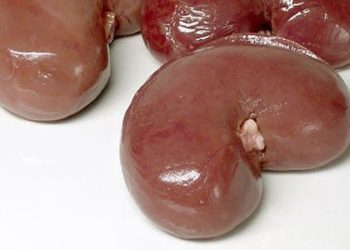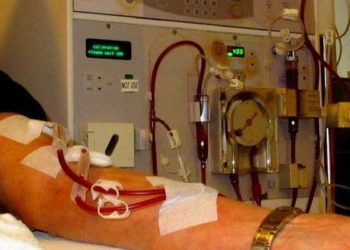Gadolinium-containing contrast associated with nephrogenic fibrosing dermopathy and systemic fibrosis [Classics Series]
This study summary is an excerpt from the book 2 Minute Medicine’s The Classics in Medicine: Summaries of the Landmark Trials
1. Among patients with end-stage renal disease (ESRD), gadolinium (Gd) containing MRI contrast agents were found to trigger nephrogenic fibrosing dermopathy (NFD) or nephrogenic systemic fibrosis (NSF) within 1 month of administration.
2. The half-life of gadolinium is dramatically prolonged in ESRD and when combined with metabolic acidosis, may contribute to dissociation of the Gd-ligand complex, allowing tissue precipitation of Gd salts.
Original Date of Publication: June 2006
Study Rundown: Gadolinium-containing contrast agents are used in MRI examinations to reduce the T1 relaxation time of water molecules as they intermittently bind to the paramagnetic metal center, providing increased MR signal. They are typically considered very safe agents even among those with renal insufficiency, with a low rate of adverse reactions and a half-life of roughly 2 hours in those without kidney disease. However, among patients with impaired renal function, that half-life may extend to as long as 120 hours, and it has been proposed that this prolonged exposure may lead to Gd-salt deposition within body tissues and subsequent complications, such as NFD or NSF. NFD is an acquired, idiopathic disease of those with renal failure characterized by painful thickening and induration of the skin, particularly in the distal extremities. NSF is a variant of the same disease in which there is systemic involvement beyond the skin, affecting the joints, lungs, heart or liver. The present study described a case-control series in which patients with ESRD underwent Gd-enhanced MR angiography (MRA) and developed symptoms of either NFD or NSF, and was among the first publications to describe the association between Gd and these diseases. Of the 9 patients who underwent Gd-enhanced MRA over 2 years, 5 developed skin symptoms suggestive of NFD with characteristic histopathological changes. The most significant differences between those who developed symptoms and those who did not were the presence of a significant metabolic acidosis and a prolonged history of dialysis among those affected versus those unaffected. Despite the inherent limitations of a case-control series study examining a rare disease entity with limited sampling, this study introduced a now common association between Gd-contrast agents and NFD or NSF among ESRD patients.
Click to read the study in Nephrology Dialysis Transplantation
In-Depth [prospective cohort]: This series identified 9 dialysis-dependent patients (mean age 58±10.3 years) over a 2 year period who underwent Gd-enhanced MRA with gadopentetic acid, 5 of whom developed skin symptoms suggestive of NFD with characteristic histopathological changes. Baseline characteristics of those affected were compared to those unaffected in an effort to identify potential risk factors for the development of NFD or NSF. In each index case, skin changes occurred 2-4 weeks following the initial administration of gadopentetic acid, and clinical courses were uneventful. Only two major differences were identified between the two patient groups: their mean time on dialysis and their pH values. Those affected had a mean time on dialysis of 36±16.5 months versus 23.75±12.5 months for those unaffected. Additionally, those affected uniformly displayed a metabolic acidosis with an average pH of 7.29±0.04 and serum bicarbonate of 19.5±1.7 mmol/L versus 7.39±0.01 and 22.95±0.58 mmol/L respectively, for those unaffected. A laboratory review including antinuclear antibodies, antineutrophil cytoplasmic antibodies, antiphospholipid antibodies, immune complexes, anti-glomerular basement membrane antibodies and complement factors were unremarkable among both those affected and unaffected. A single affected patient displayed decreased levels of protein C and increased levels of Factor VIII. No medications were identified in common between any of the nine patients. In those with ESRD, the half-life of Gd-containing compounds is significantly prolonged, and multiple metabolic derangements are often present including metabolic acidosis. This may predispose to dissociation of the Gd ion from its contrast complex, allowing formation of Gd-salts with free anions such as phosphate, which is often increased in concentration in dialysis patients. It was proposed, though without direct evidence, that these salts may precipitate into tissues and trigger the symptoms of NFD or NSF in susceptible patients.
Grobner T. Gadolinium – a specific trigger for the development of nephrogenic fibrosing dermopathy and nephrogenic systemic fibrosis? Nephrology Dialysis Transplantation. 2006 Jan 21:1104–08.
©2022 2 Minute Medicine, Inc. All rights reserved. No works may be reproduced without expressed written consent from 2 Minute Medicine, Inc. Inquire about licensing here. No article should be construed as medical advice and is not intended as such by the authors or by 2 Minute Medicine, Inc


![The ABCD2 score: Risk of stroke after Transient Ischemic Attack (TIA) [Classics Series]](https://www.2minutemedicine.com/wp-content/uploads/2013/05/web-cover-classics-with-logo-medicine-BW-small-jpg-350x250.jpg)



